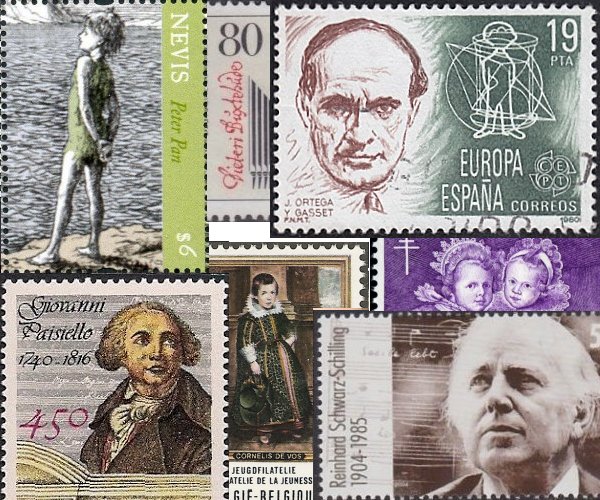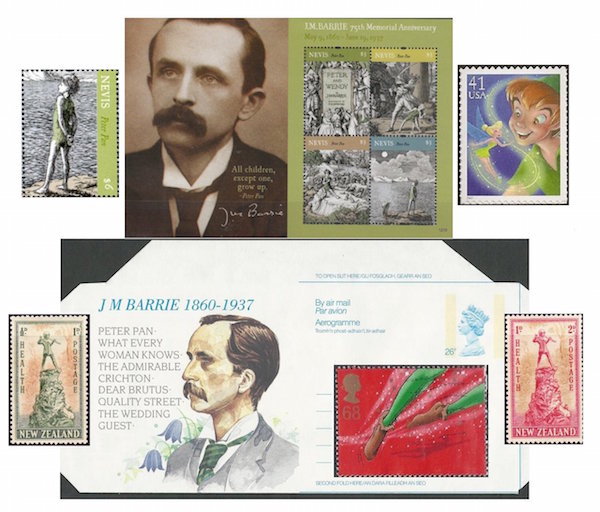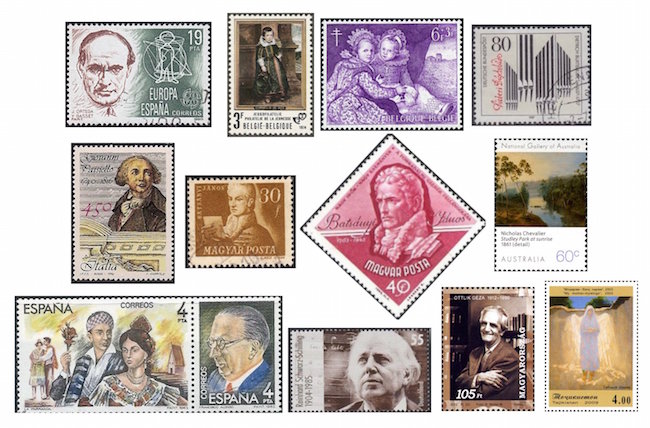The Arts on the Stamps of the World — May 9
An Arts Fuse regular feature: the arts on stamps of the world.

By Doug Briscoe
The biggest name on the marquee today is J. M. Barrie. Second billing goes to the great Spanish essayist José Ortega y Gasset. Three composers were all born on May 9, and a fourth, Dieterich Buxtehude, died on this date in 1707. Plus we have our more-or-less usual assortment of Flemish painters (1), Hungarian writers (2), and Tajik graphic designers—well, OK, Tajik graphic designers are not so usual.
James Matthew Barrie (9 May 1860 – 19 June 1937) presents us with the opportunity for a philatelic first here on The Arts on the Stamps of the World, our first occasion for an aerogramme. In the US we used to call these air letter sheets. Above that we see a handsome minisheet issued by the island of Nevis, which has a long tradition of issuing attractive stamps. To its left is the stamp from an accompanying minisheet, both having been released in 2012 on the 75th anniversary of the author’s death. At the right is the American Peter Pan stamp, the purpose of which was more Disney than Barrie. On either side of the aerogramme I’ve placed a pair of New Zealand stamps that reproduce Sir George Frampton’s charming Peter Pan statue for Kensington Gardens in London, and at lower right is one of a set of UK Peter Pan stamps from 2002. (I happen to have a lot of these if you want one.) Barrie did write quite a lot of other things, plays and novels and, curious about Barrie’s other work, I fairly recently read his novel The Little Minister (1891), which was, eh, y’know, all right. Barrie was made a baronet by King George V in 1913.

The philosopher José Ortega y Gasset (9 May 1883 – 18 October 1955) was born in Madrid into a family of liberal newspaper people. After earning a doctorate in philosophy he continued his studies in Germany for the next two years in no fewer than five different cities. When he got back to Spain in 1908 he became a professor of psychology (I was surprised to learn that such a position existed at that time), logic, and ethics. The essays that would form his two major works, Invertebrate Spain (España invertebrada, 1921) and The Revolt of the Masses (La rebelión de las masas, 1930), were intially published in a periodical. Ortega left Spain for the duration of the Civil War, living in Argentina until his return to Europe (neutral Portugal) in 1942. He came home to Spain in 1948. As no student of philosophy, I have no insights to offer.
Born in Hulst at some point in the year 1584, Cornelis de Vos (who died on this date in 1651) went with his family to Antwerp when he was twelve. He became not only one of the leading portrait painters in the city but also an art dealer. Although he produced genre paintings aplenty, he is particularly admired for his portraits of children and families. On the subject of family, he was surrounded by painters, his brother Paul de Vos (1595-1678), his sister Margaretha’s husband Frans Snijders (1579-1657), and his wife’s half-brother Jan Wildens (1584/86-1653). These artists often worked as a team, with de Vos concentrating on the figures while the others worked on the backgrounds. De Vos also regularly collaborated with Rubens. The first of the two stamps reproduces his Portrait of Frans Vekemans (c1625), a companion piece portraying his brother Jan can be seen here. The second stamp gives us Magdalena and Jan-Baptist de Vos, the artist’s two eldest children (c1622). For more on de Vos I refer you to revolvy.com.
As with de Vos, we don’t know the exact date of the birth of German composer Dieterich Buxtehude (c1637-39), but he died on May 9, 1707, so I thought we’d remember him today. A precursor of and influence on Bach, Buxtehude (BOOKS-teh-HOO-deh), whose father was also an organist, left many organ works, harpsichord pieces, chamber cantatas, etc.
Giovanni Paisiello, by contrast, was a composer of opera. He wrote 94 (!) of them, one of them being a very popular version of The Barber of Seville (1782), which preceded Rossini’s now much more famous version by some 34 years. Of course, one wouldn’t expect any eighteenth-century composer worth his salt to leave behind so paltry a body of work as a mere 94 operas; Paisiello also wrote a dozen oratorios, over a hundred other sacred works (masses, etc.), two dozen secular cantatas, and a respectable number of keyboard concertos (8) and string quartets (9), wind music, and a single symphony. He served as the courts of Catherine the Great (for eight years) and Napoleon. Paisiello was born on this day in 1740 and died on 5 June 1816, the year of Rossini’s Barber.
Now to the first of today’s two Hungarian writers, János Batsányi (May 9, 1763 – May 12, 1845), a political activist who first came to notice with a patriotic poem called “The Valor of the Magyars” and went on to co-edit the first important Hungarian language journal, the Magyar Museum. The Austro-Hungarian government closed that operation down in 1792, and on Batsányi’s association with the Jacobin conspirator Ignác Martinovics two years later deprived him of his clerkship and threw him into the clink. When he got out he started up another magazine, this time a literary one, and moved on to Vienna, where, unable to stay out of trouble, he translated Napoleon’s proclamation to the Hungarians and had to flee to Paris as a result. After Napoleon’s downfall Batsányi was placed under arrest but allowed to live in relative freedom in Linz as long as he stayed there. In 1827 he managed to get a book of poems published in Pest.

The painter Nicholas Chevalier (9 May 1828 – 15 March 1902) was born in St. Petersburg to a Swiss father and Russian mother and lived in Russia until he was 17, whereupon he studied painting in oils at Lausanne and Munich. Next it was on to London, where he worked as a lithographer and water-colorist. Still more study in Rome followed, and then Chevalier joined his equally peripatetic father and brother in Australia, working there as—wait for it—a cartoonist for the Melbourne Punch. His painting The Buffalo Ranges (1864) was selected as the winner of a contest to supply the newly founded National Gallery of Victoria with a new work by a local artist. The next year saw Chevalier taking off for a visit to New Zealand, and four years later he was on board the HMS Galatea for a round-the-world trip as painter to the Duke of Edinburgh; stops were made in Tahiti, Hawaii, Japan, China, Ceylon, and India, and Chevalier painted everywhere, having a show of the work at Kensington on his return to England. Now, get this, in 1874 Queen Victoria, no less, gave him the commission to travel to—wait for it—Saint Petersburg so as paint the marriage of the aforesaid Duke of Edinburgh. London was his headquarters thereafter. The lovely Australian stamp shows Chevalier’s Studley Park at Sunrise (1861).
The Spanish composer Francisco Alonso (1887 – Madrid, 18 May 1948) focused on light works for the stage. After the deaths of his parents, Alonso went at about age 21 to Madrid, where he worked for several years before achieving his first success with the revue Música, Luz y Alegría (1916). The 1919 show Las Corsarias contained a song, “La Banderita”, which became so enormously popular in Spain that King Alfonso XIII was heard singing it while shaving. Thereafter, Alonso’s future was assured. The pair of stamps shows the composer and a scene from his zarzuela (essentially a Spanish form of operetta) La Parranda (1928).
German composer Reinhard Schwarz-Schilling (1904 – 9 December 1985) wrote music in various genres. Although a devout Catholic, he married a Jewish pianist; they lived in considerable danger with falsified papers in the Third Reich. Naxos has issued two CDs of his orchestral works, and there’s an album of his organ music on Thorofon.
Unable to publish his own fiction in post World War II Hungary, Géza Ottlik (9 May 1912 – 9 October 1990) made many translations from English (four Dickens novels, GB Shaw, Hemingway, Evelyn Waugh…) and concentrated on his specialty, championship bridge. Only with the end of the Rakosi regime in 1956 was he able to see his first novel, Rooftops at Dawn (1957), and other works into print. His 1979 book Adventures in Card Play, co-authored with Hugh Kelsey, is held in high regard by bridge players the world over. During the war he had protected the Jewish writer István Vas by hiding him in his home and somehow managed also to prevent Vas’ mother from being deported. For these services he was posthumously honored as Righteous Among the Nations.
Finally today we turn to the Tajik graphic designer Sabzali Sharif (born May 9, 1946), now recognized as a National Artist of Tajikistan. His work My Mother, My Wings (2003) was reproduced on a 2009 stamp.
Happy birthday to these highly gifted Britons: Alan Bennett (born 9 May 1934), Albert Finney (1936), and Glenda Jackson (1936), and to these highly gifted Americans: Candice Bergen (1946) and Billy Joel (1949).
A graduate of the University of Massachusetts with a B.A. in English, Doug Briscoe worked in Boston classical music radio, at WCRB, WGBH, and WBUR, for about 25 years, beginning in 1977. He has the curious distinction of having succeeded Robert J. Lurtsema twice, first as host of WGBH’s weekday morning classical music program in 1993, then as host of the weekend program when Robert J.’s health failed in 2000. Doug also wrote liner notes for several of the late Gunther Schuller’s GM Recordings releases as well as program notes for the Boston Classical Orchestra. For the past few years he’s been posting a Facebook “blog” of classical music on stamps of the world, which has now been expanded to encompass all the arts for The Arts Fuse.
